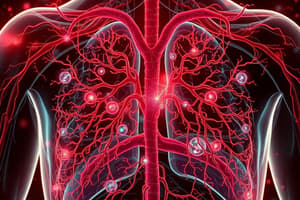Podcast
Questions and Answers
Why do multicellular organisms require a circulatory system?
Why do multicellular organisms require a circulatory system?
- To transport nutrients and oxygen to cells that do not contact the environment directly (correct)
- To increase the energy consumption of the organism
- To provide direct contact between cells and the environment
- To maintain a constant temperature throughout the body
What is a fundamental feature of a circulatory system?
What is a fundamental feature of a circulatory system?
- Network of tubes for fluid circulation (correct)
- Absence of any pumping mechanism
- Fluid that does not transport materials
- Presence of external respiratory structures
How does an open circulatory system differ from a closed circulatory system?
How does an open circulatory system differ from a closed circulatory system?
- Open circulatory systems require more energy to operate than closed systems
- In open circulatory systems, organs bathe directly in hemolymph (correct)
- Blood is always contained in vessels in an open circulatory system
- Open circulatory systems have a true heart for pumping blood
What is the color of oxygen-poor blood?
What is the color of oxygen-poor blood?
Which organism would most likely have a closed circulatory system?
Which organism would most likely have a closed circulatory system?
What is the main function of hemoglobin in red blood cells?
What is the main function of hemoglobin in red blood cells?
Which plasma protein is primarily responsible for maintaining osmotic pressure in the blood?
Which plasma protein is primarily responsible for maintaining osmotic pressure in the blood?
What type of white blood cell is primarily involved in combating infections by ingesting bacteria?
What type of white blood cell is primarily involved in combating infections by ingesting bacteria?
How does high sodium ion concentration affect blood volume?
How does high sodium ion concentration affect blood volume?
Where are red blood cells primarily produced in the human body?
Where are red blood cells primarily produced in the human body?
Flashcards
Circulatory System
Circulatory System
A system that transports nutrients, oxygen, and waste products throughout the body.
Blood
Blood
The fluid that circulates through the body, carrying essential substances.
Open Circulatory System
Open Circulatory System
A type of circulatory system where the blood is not confined to vessels and directly bathes organs.
Closed Circulatory System
Closed Circulatory System
Signup and view all the flashcards
Systemic Circuit
Systemic Circuit
Signup and view all the flashcards
Plasma
Plasma
Signup and view all the flashcards
What is the function of red blood cells?
What is the function of red blood cells?
Signup and view all the flashcards
What is the role of white blood cells?
What is the role of white blood cells?
Signup and view all the flashcards
Hemoglobin
Hemoglobin
Signup and view all the flashcards
Fibrinogen
Fibrinogen
Signup and view all the flashcards
Study Notes
Circulatory Systems
- Not all organisms need a circulatory system. Unicellular and some simple multicellular organisms have direct contact with the environment. Sponges are an example.
- Multicellular organisms require circulatory systems to transport oxygen and nutrients to cells and remove waste products since they can't directly access those things.
- A circulatory system typically includes a fluid, a network of tubes, and a pump.
- Two types of circulatory systems exist: open and closed.
Open Circulatory Systems
- Fluid is called hemolymph and is not always contained in vessels.
- Uses less energy and has low blood pressure.
- Organs are bathed in the hemolymph for exchange of oxygen, nutrients and waste.
- Examples include insects, lobsters, crabs, and oysters.
Closed Circulatory Systems
- Blood is confined to a network of vessels.
- Has higher flow rate.
- Blood flows in one direction.
- Suitable for larger, faster metabolising organisms with a need to remove waste quickly.
- Examples include birds, mammals, fish, and reptiles.
Human Circulatory System
- The human circulatory system is a closed system.
- The human body contains approximately 4-5 liters of blood.
- Blood is composed of cells and a liquid matrix called plasma.
- Blood components can be separated using a centrifuge.
Blood Components
Plasma
- Mostly water (about 90%).
- Contains proteins (albumins, globulins, fibrinogen), nutrients, gases (oxygen, carbon dioxide), waste products and electrolytes (ions).
- Osmotic pressure is regulated by sodium ions.
Red Blood Cells
- Produced in red bone marrow.
- Contain hemoglobin (iron-containing) for oxygen transport.
- Very flexible to pass through capillaries.
- Removed and broken down by the spleen when old.
White Blood Cells
- Various types (neutrophils, lymphocytes, monocytes, eosinophils, and basophils) with different roles in fighting infection.
- Neutrophils: Ingest bacteria.
- Lymphocytes: Produce antibodies.
- Monocytes: Ingest foreign bodies.
- Eosinophils: Combat parasites and increase allergic reactions.
- Basophils: Release histamine and heparin.
Key Functions of Circulatory System
- Delivers oxygen from respiratory system.
- Delivers nutrients from digestive system.
- Delivers hormones from endocrine system.
- Delivers immune cells and chemicals.
- Removes metabolic wastes.
- Maintains body temperature (in warm-blooded animals).
Blood Circulation
- Systemic circuit: Blood circulation through the head and body.
- Pulmonary circuit: Blood circulation between the heart and lungs for oxygenation.
- Oxygen rich blood is bright red.
- Oxygen poor blood is deep red.
Studying That Suits You
Use AI to generate personalized quizzes and flashcards to suit your learning preferences.




